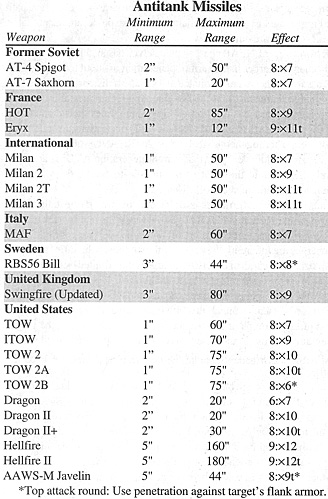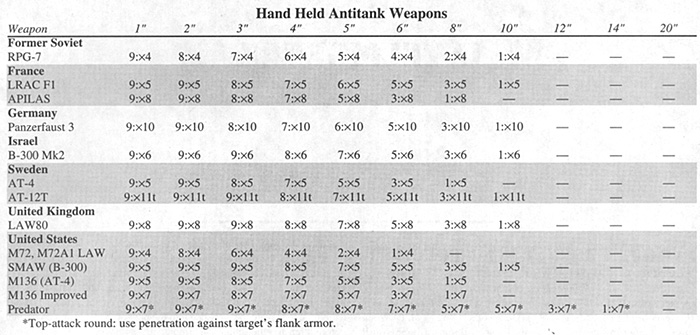 One piece of data that is frequently overlooked in Combined Arms is Frank's weary disclaimer at the end of his Designer's Notes, to whit: "When time proves me wrong (as it has a nasty habit of doing), I hope you'll remember that, despite the 1988 copyright date, I actually designed this game in 1972 and thus can hardly be held responsible for information appearing after that time."
One piece of data that is frequently overlooked in Combined Arms is Frank's weary disclaimer at the end of his Designer's Notes, to whit: "When time proves me wrong (as it has a nasty habit of doing), I hope you'll remember that, despite the 1988 copyright date, I actually designed this game in 1972 and thus can hardly be held responsible for information appearing after that time."
Those of you who have read my "Huzzah" article in CPQ 7 will note the significant changes in ratings of the Soviet tanks based upon new information. The fact that these revisions have a clear impact on play balance in CA is a nasty by-product of real life, and thoughtful readers will suspect that the same forces that led to this data slippage over time are working their nefarious business elsewhere in the CA ratings. Sad but true. This article attempts to present CA/CDII ratings for ATGMs and hand-held AT weapons based on up-to-date information. This cannot help but mess with play balance assumptions again, which may well require lurther revisions elsewhere later on to keep various rating, in synch with each other. In simulation as in life, growth na a painful process, a tact for which I would apologize if it were my fault, but it uin't. All we can do is bear with it. So let's get bearing. HOO-AH!
Although there are ATGMs under dcvelopment (such as the American LOSAT) which derive then- killing powm from kinetic energy, all currently deployed A'TGMs and manportatble AT rockets and recoilless rifles penetrate their targets via shaped charges (a.k.a. HEAT. HEAP. hollow charge) in some configuration or other. Although there is still some confusion in official literature about the details of shaped charge function (does the jet of molten metal penetrate by its own kinetic energy alone, or do the hot gases precede the metal jet, burning a path through the armor- through which the metal jet follows?), it is clear that shaped charges are rather finicky in practice. Although they have impressive armor-penetrating potential, achieving this potential relies on the warhead being detonated at a proper stand-off distance and angle with relation to the arnuor to be penetrated. Countermeasures against HEAP warheads (aside from the obvious increases in armor thickness and toughness) have relied on preventing the proper detonation of these warheads.
Simple vcrsions of this are stand-off armor plate as used by the Germans in World War II or chain-link fence as used by US forces in Vietnam to cause the warhead to detonate prematurely and dissipate its power too far from the armor. Spaced armor works on the same principle. More complex versions are chobham armor and explosive reactive annor. Chobham armor appears to gain its outstanding cffcctivencss against HEAP rounds by allowing its internal ceramic and epoxy layers to slide against each other, bringing more armor material into contact with the penetrating jet. Explosive reactive armor (ERA) uses a aimilar principle. Each plate of ERA is actually a sandwich of explosives between two metal plates. As the outer metal plate is penetrated by the HEAP jet, the explosive material detonates, driving the outer plate into the path of thejet, and bouncing the inner plate off of the base armor, and back into the path of the jet. Because these two plates will almost always be travelling obliquely to the path of the jet, their movement across the jet causes additional new plate to be pushed into the path of the jet, using up its energy before it reaches the actual hull art-nor.
Counter-countermeasures have been applied to antitank weapons in the form of tandem warheads to allow them to defeat ERA. In a tandem warhead, the first, or "precursor," warhead detonates the reactive armor, clearing a path to the hull armor against which the main warhead explodes an instant later, after the ERA plates are out of the way.
The performance of HEAP charges themselves has also improved. First generation shaped charges had an armor penetration of about four times their diameter, assuming they were detonated at a stand-off distance of two to four times the charge diameter. Improved engineering techniques allow current generation HEAP warheads to penetrate up to nine times their diameter, at stand-off distances of six to eight diameters. (All penetrations are calculated in terms of "rolled homogeneous steel armor," or RHA, the standard measure of effective armor equivalency.) Most current-generation ATGMs are fitted with stand-off probes at the front of the missile to ensure the warhead's detonation at the optimum stand-off distance.
In addition, HEAP performance is affected by the way it is installed in the missile. Most top-attack missiles fly over the top of the enemy tank and fire one or more HEAP charges downward, off of the missile's axis of flight. Such off-axis charges are inherently less powerful than those which fire along the missile's axis, as the length of the HEAP charge is now limited by the diameter of the missile, and therefore must be a smaller, and less powerful, charge. Fortunately the top armor of most tanks is thin enough that even this reduced penetration is sufficient to punch this vulnerable area. However, the newest generation of tanks are paying more attention to top armor, and the United States' new Javelin missile addressed this by being a top-attack missile which dives onto its target from above, allowing it to be fitted with more powerful axial warheads.
An additional wrinkle in hand-launched "unguided" AT rockets is the fact that some of them aren't quite so unguided anymore. The USMC's new Predator has its own inertial system that allows for the effects of wind and production tolerances in the round's rocket motor. Thus, although the Predator is aimed and fired like any other unguided rocket, once it is out of the tube, it stands a better chance of getting to where it was pointed.
Note that on the tables below there is a new notation in the Effect column, the letter "t." This denotes a missile or AT weapon fitted with a tandem warhead. Weapons with tandem warheads disregard the effects of reactive annor ( i.c.. they do not have their die roll for penetration halved; see CD 2 rule 7.6. page 60), but still force the target to roll to see if the reactive armor has been expended so it no longer protects the vehicle (rule 7.6, page 60-61).
Although the small precursor warhead does add a marginal amount of additional pure penetration (i.e., by actually penetrating hull armor in advance of the main charge), its major function is to increase the effective penetration of the warhead set by preventing the reactive armor from degrading the penetration of the main warhead. This is captured by the "t" effect, and these missiles are not credited with any additional pure penetration resulting from the precursor warhead against a non-reactive armored target.
Tandem warheads do not have any effect on chobham ("c") armor.
The tables here are by no means an exhaustive listing of all currently deployed antitank weapons, but are a start. Further ratings will be presented in future issues of CPQ as opportunities present themselves.
ADDITION TO TANK DATA IN CPQ 7
The production version of the Challenger 2 is said to have the finest turret top armor in the world, an additional three inches of chobham armor added to what was already there. The listed flank armor values for the Challenger 2 are used when the tank is hit from the sides, but when the tank is hit by a top attack missile from the frontal arc. use the armor value 40c.
For future use, Challenger 2 and other such tanks will have armor values listed as: 60c117c{40c} where the enhanced top attack "flank" armor is contained within the braces { like so } .
BIBLIOGRAPHY
Biass, Eric H., and Doug Richardson. "Dawn of the Digital Tank," Armada International, 3/1994.
Biass, Eric H., and Doug Richardson. "Fear Me Now, Tank!" Armada International, 2/1994.
Zaloga, Steven. "Russian Guided Tank Projectiles." Jane's Intelligence Review. July 1993.
Zaloga, Steven. "Russian Missile Designations,", Jane's Intelligence Review, August 1994.
Zaloga, Steven J. "Worldwide Developments in Armor/Anti-Armor." Lecture, Fall 1989.
Personal sources.

Back to Table of Contents -- Command Post Quarterly # 8
To Command Post Quarterly List of Issues
To MagWeb Master Magazine List
© Copyright 1995 by Greg Novak.
This article appears in MagWeb.com (Magazine Web) on the Internet World Wide Web.
Other articles from military history and related magazines are available at http://www.magweb.com
